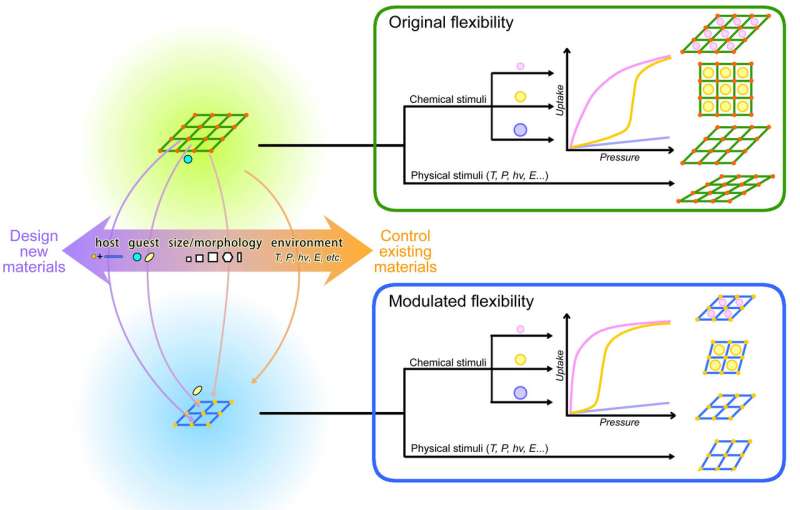Flexible metal-organic frameworks: from controlling the structures to controlling the flexibility. Credit: Science China Press
Porous coordination polymers (PCPs) or metal-organic frameworks (MOFs) have been extensively studied for their diversified and designable/tailorable framework and pore structures. Compared with conventional porous materials, MOFs have much larger framework flexibility, which can give rise to not only various types of interesting structural responses and dynamic behaviors toward external stimuli, but also significantly improved performances for storage, separation, sensing and other applications. Therefore, controlling the flexibility of MOFs, or rational design and synthesis of MOFs with specified flexibility and dynamism, are of practical importance. However, framework flexibility is simultaneously controlled by many factors, and a trivial difference of a structural parameter or other factor related with the sample or environment can drastically change the response. In other words, framework flexibility can be more difficult to design or control, compared with the static features such as framework and pore structures.
In a new review published in the Beijing-based journal National Science Review, scientists at the Sun Yat-Sen University in Guangzhou, China, present the advances in designing/controlling the flexibility of MOFs. Co-authors Jie-Peng Zhang, Hao-Long Zhou, Dong-Dong Zhou, Pei-Qin Liao and Xiao-Ming Chen first define and distinguish the concepts of controlling the structure of flexible MOFs and controlling the flexibility of MOFs. The former refers to the change of framework structures of flexible MOFs toward external chemical (guest adsorption/desorption/exchange) and physical (temperature, light, pressure, etc.) stimuli, which is the intrinsic property of flexible MOFs and has been the topics of most researches. On the other hand, the latter uses external environment to modulate the structural response and dynamic behavior of MOFs, or designs/synthesizes new MOF materials/samples to generate specified structural response and dynamic behavior toward a given external stimulus. Based on discussions of representative examples, they systematically summarize the basic strategies for designing/controlling flexibility of MOFs, i.e., design, synthesis, and modification of the porous host, controlling the composition and size/morphology of the porous crystal sample, and controlling the external physical environment, in which the target gradually changes from designing new materials to modulating the property of existing materials.
The scientists emphasize that, "It should be pointed out that, designing, tailoring, or controlling framework flexibility is not only useful for understanding the structure-property relationship of MOFs, but also a new dimension for developing MOF materials with excellent performances for molecular recognition, high storage/delivery capacity, selective separation, abnormal/controllable thermal expansion, and so on."
More information: Jie-Peng Zhang et al, Controlling flexibility of metal–organic frameworks, National Science Review (2017). DOI: 10.1093/nsr/nwx127
Provided by Science China Press























